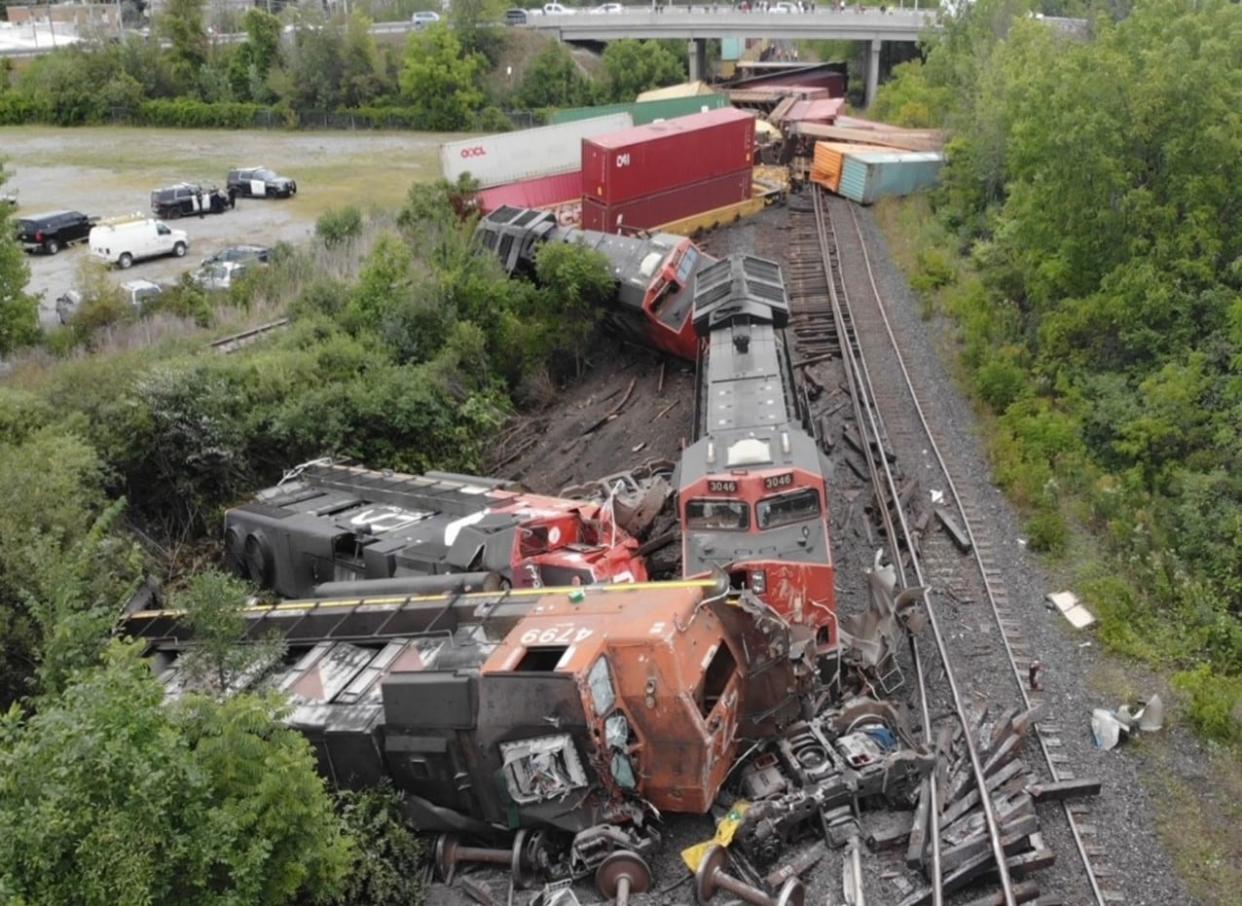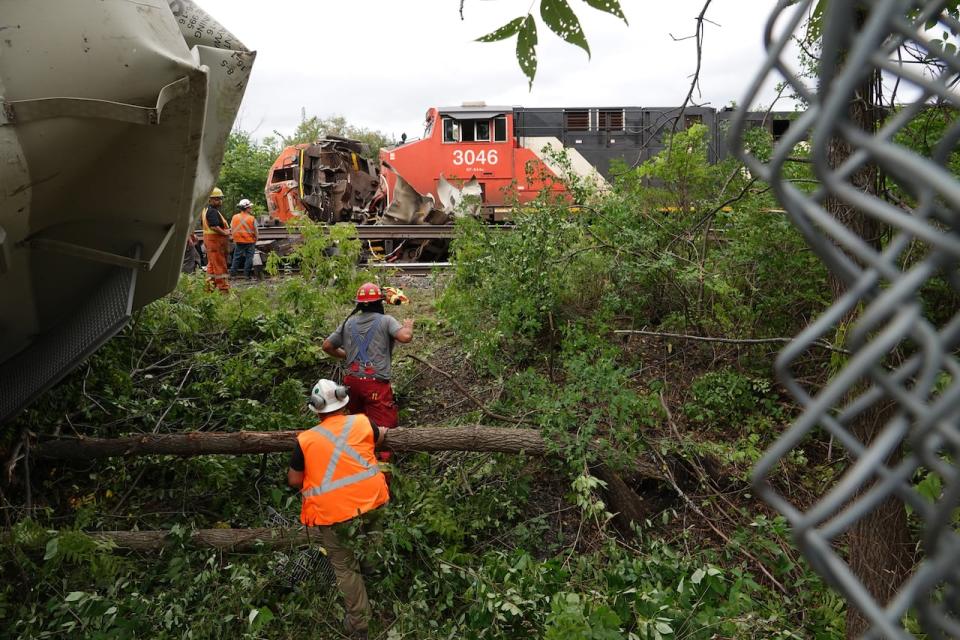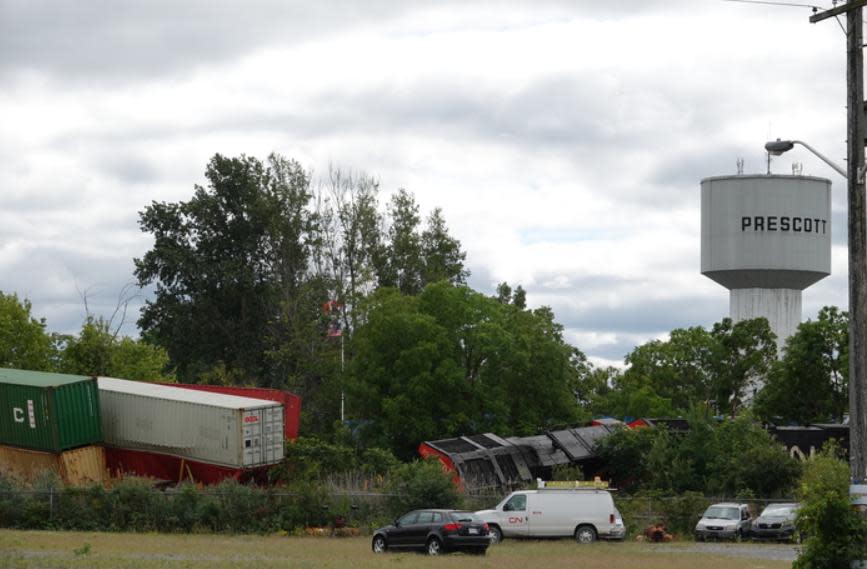Alcohol a possible factor in Prescott train crash, TSB says

The Transportation Safety Board (TSB) says alcohol was a possible factor in a serious collision between two trains in Prescott, Ont., two and a half years ago — but a rail safety expert says the watchdog's report falls short by failing to include recommendations.
Three crew members were injured, one seriously, in the head-on crash on the morning of Sept. 2, 2021, when a CN freight train pulling 202 double-stacked container cars crashed into another CN train consisting of two engines.
The TSB investigation released Wednesday found the rail traffic controller (RTC), who was stationed in Edmonton at the time of the collision, had an elevated blood alcohol level hours after the crash.
The RTC's blood-alcohol level likely ranged from 0.064% to 0.109% when he started his shift earlier that morning, and from 0.044% to 0.069% at the time of the collision, the TSB found.
According to the U.S. Federal Aviation Administration, that's enough alcohol to affect one's judgment and diminish their attention.
A report by the chief medical review officer "indicated that the RTC was either drinking alcohol at the beginning of his shift or had significant alcohol intake the early morning of or the night before work," the TSB said.
"This was an accident that resulted from a convergence of several factors, not just the consumption of alcohol. But certainly that was a red flag for us, a warning, that more needs to be done to reduce the risk of railway employees conducting their activities, their work, while impaired," TSB chair Kathy Fox told CBC News.
3 injured in head-on crash
Those factors also included the RTC's busy workload and his ability to override the safety system despite a warning.
The TSB found the RTC asked the utility train to clear the main track around 9:47 a.m., and wait on a spur line to allow the freight train to pass on its way to Toronto.
A little over 30 minutes later, the crew of the first train asked the RTC to allow it back onto the main track to continue toward Brockville, Ont. That involved a crew member manually switching the track, the TSB said.
The RTC approved the request despite a warning showing on his monitor that another train was within a 23-kilometre limit of the switch. Instead of pressing "abort" on the screen, he pressed "continue," allowing the track to be switched, the TSB said.

Workers check the damage to one of the trains involved in a collision in Prescott, Ont., on Sept. 2, 2021. (Frédéric Pepin/Radio-Canada)
As the westbound freight train approached the switch, the crew realized the error and attempted to brake. However, the train was forced onto the spur line where it collided head-on with the waiting train at around 60 km/h.
One crew member on the utility train suffered serious injuries and had to be hospitalized, while two others on the same train suffered minor injuries. No one on the freight train was hurt.
"It was significant because it was a head-on collision between two trains," said Fox, who noted one of the trains involved consisted only of two locomotives.
"But it could have been a train carrying cars with dangerous goods. It could have been a passenger train," she said.
Four engines, two on each train, were heavily damaged and derailed in the collision, and 14 freight cars also derailed.
The crash caused significant damage to a total of about 300 metres of both the main track and the spur line, the TSB said.
"That's a major collision ... that shouldn't happen," said Ian Naish, a rail safety consultant and ormer director of rail investigations for the TSB.
"I'm surprised nobody died."

Two trains collided and derailed in Prescott, Ont., a community south of Ottawa on the St. Lawrence River, on the morning of Sept. 2, 2021. ( Frédéric Pepin/Radio-Canada)
CN, expert question lack of recommendations
Naish said he had two big takeaways from the report that show "significant safety deficiencies."
The first was the presence of a manual switch, when he believes electronic switch locks could have prevented the collision because they would have identified that there was already a train on the tracks.
The second issue, said Naish, was that the TSB didn't make any recommendations on the switch system or impairment rules for rail employees.
"It shouldn't be that big a deal to make a recommendation," Naish said, adding that he would have done so. "There's nothing wrong recommending Transport Canada to take a look."
Fox, the TSB's chair, said while the board stopped short of making recommendations in this case, it did express concern that at the time of the collision there was no policy under the Railway Safety Act prohibiting employees from consuming alcohol within a certain period before their shift.
She said the federal transport minister can change rules prohibiting alcohol or drugs without having to amend the act.
Transport Canada said in an email Thursday it's reviewing the TSB's report. It pointed out the Canadian Rail Operating Rules also prohibit the use or possession of intoxicants and/or narcotics both on duty and before going on duty.
The TSB also pointed out that CN has zero tolerance for impairment, but "individuals are expected to self-assess and determine if the effects of alcohol have sufficiently diminished to be fit for duty."
In contrast, it found aviation regulations prohibit the operation of aircraft within 12 hours of consuming alcohol, and prohibit air traffic controllers from drinking within eight hours of their shift.

Ian Naish is a consultant and former director of rail investigations with the Transportation Safety Board. He questions why the TSB didn't make any recommendations from this significant event. (Jean Delisle/CBC)
In a statement to CBC, CN said it's disappointed the TSB didn't issue any recommendations concerning drug and alcohol consumption.
"CN remains firm in its belief that random testing employees in safety-critical positions is the only way to deter impairment at work," it said.
Fox said the TSB has investigated five incidents in the last 29 years in which alcohol or drugs were considered a factor, but weren't necessarily the cause.


